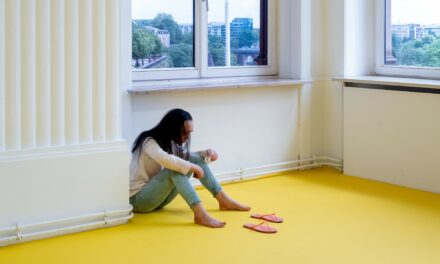The collaboration among the model/living canvas (our very own Luxembourger Kim Jones), the rigger (Bob, RopeMarks), the calligrapher (Nicolle Bötcher), and the photographer (Ofir Abe) forms a creative powerhouse that thrives on mutual trust and the synergy of their talents. They call themselves the Callibari Collective. It all started approximately two years ago when these four decided to make a mark with their distinctive blend of art forms.
Callibari predominantly exists as a live performance but, thanks to artistic documentation, it is also preserved in various art mementos, mainly photographs – unique moments frozen within the continuum of time, moments that would otherwise be invisible to us. Snap!
Breath and knot, but what does Callibari mean? It’s a fusion of Calligraphy, Shibari, and artistic collaboration. Perhaps the least known out of the three is Shibari, the dance between control and surrender or restraint and freedom, also known as Kinbaku, whose roots go back to ancient Japan, where it flourished as both an erotic and aesthetic practice. The word Shibari itself means “to tie” or “to bind” in Japanese, reflecting the essence of this complex art form, emphasizing not only the effectiveness of binding but also the aesthetics of the knots and patterns. The delicate balance between the one tying (the rigger) and the one being tied (the model or the bunny) becomes a platform for vulnerability and connection. Historically, this rope-tying method was not only used as a form of pleasure, but also as meditation, relaxation, and trust-building practice between two partners. Callibari extends this trust further with the ability to connect multiple diverse art forms, allowing each artist to contribute their strengths while challenging and enriching the work of others. This fragile harmony among individual voices within the collective demands a nuanced approach to balance the ego and foster genuine cooperation. In the end, it is on the audience itself to ponder whether the benefits of collaboration truly manifest or if the artistic mix risks potential weakening due to compromise.
At first glance, Shibari and Calligraphy may seem worlds apart, one involving ropes and knots, and the other, strokes and ink or color. However, a closer look reveals deep similarities that connect these two together. Calligraphy, derived from the Greek words kallos (beautiful) and graphein (to write), is an ancient art form that has left an undeniable influence across diverse cultures worldwide. From ancient China to contemporary graffiti, calligraphy has evolved, embodying discipline, spirituality, and self-expression. Similar to Shibari, it requires precision, skill, and dedication, to transform words into visual poetry. Stroke!
Both art forms prioritize beauty as an essential element. That, however, is not enough. Mastery is a must. In Shibari, it’s the intricate patterns of the ropes, the placement of knots, the body formation, and the unity between the rigger and the model. In Calligraphy, the mastery lies in the refined application of individual strokes, the spacing of letters, and the overall composition in order to produce a visually impactful result. Both carry unique personal styles and artistic interpretations, inviting viewers to connect with the emotions manifested in the work. Lastly, both Shibari and Calligraphy bring rich cultural narratives that have developed over centuries across cultures and highlight their shared significance as tools of tradition and cultural expression. These analog methods lead us to slow down and learn how to be in the moment with our senses, while we live in the era of Apple’s Vision Pro, and other gadgets creating completely new virtual worlds for us. Callibari also brings people together by collaborating much further beyond the four mentioned members. There are fashion artists, make-up artists, sound designers, …, all of whom make the show – The Callibari Show, a spectacle that has dripping paint, live suspensions, musical soundscapes, and authentic stories to tell.
Story of Liberation: Unveiling the Authentic Self
However, just as Callibari holds the potential for liberation within restraint, the queer community has continually been unraveling the tangles that try to confine its members. The pursuit of equality, acceptance, and the right to express one’s identity without obstacles is an ongoing journey toward freedom. The tension between historical and societal constraints and the quest for authenticity parallels the meticulous tying and untying of knots, creating a dynamic interplay that shapes the narrative of each individual’s journey – a nuanced exchange between form and liberation. The liberation desired by many of us is not meant as a rejection of form, but rather as a celebration of diverse forms. That is one way we can “read” the atmosphere of Callibari and immerse ourselves in it. And although it is still a young collective, mostly to be seen in Amsterdam, where all members currently reside, they are slowly, but steadily starting to have an impact on bigger and bigger audiences and leaving their mark.
Callibari Collective will perform at the Rainbow Center in Luxembourg city on June 29 during the opening event of their exhibition. Knot, knot. Who’s gonna be there?
Photo: Ofir Abe





